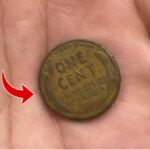Lincoln Wheat Penny Valued at $168K: A simple penny could be your unexpected jackpot. That’s the buzz surrounding a rare version of the Lincoln Wheat Penny, reportedly worth as much as $168,000 today. Originally minted between 1909 and 1958, the Lincoln Wheat Penny was once just everyday currency. But due to minting errors, limited runs, and unique historical conditions, some versions have become worth more than their weight in gold. Among these, a specific 1944 steel wheat penny has caught the attention of collectors and treasure hunters alike. What’s especially thrilling is the theory that a few of these ultra-rare coins may still be in everyday circulation—unnoticed and unvalued by the people who hold them. This possibility has reignited a nationwide hunt, with Americans turning to their coin jars and wallets, hoping to stumble upon one of the most sought-after coins in U.S. history.
The Unintentional Creation of a Rarity
The high value of the $168K Lincoln Wheat Penny is largely due to an unexpected minting mistake during World War II. In 1943, the U.S. Mint replaced copper with steel to conserve metal for the war effort. But in 1944, when copper was reintroduced, a few leftover steel planchets accidentally made it back into the minting process. This error resulted in a small batch of 1944 steel wheat pennies being produced—an unintentional anomaly that collectors now prize. Only a handful of these coins are believed to exist today, making them extremely rare. The accidental nature of the minting process, combined with the historical context of wartime America, gives this coin not only monetary value but also historical importance. It’s this blend of rarity and narrative that drives its six-figure valuation and fuels the excitement among coin enthusiasts and treasure hunters.
What Makes This Coin Worth $168,000?
It’s not just age that makes the 1944 steel wheat penny valuable—it’s a combination of mint error, scarcity, and condition. Unlike the copper pennies from the same year, the steel version was never intended to be minted, making it a mistake that turned into a collector’s dream. Its value is further amplified when found in uncirculated or near-perfect condition, which is exceptionally rare due to the coin’s accidental origin. Authentication is key—certified grading by agencies like PCGS or NGC significantly boosts credibility and price. In auctions, verified examples of this coin have sold for more than $150,000, with some experts estimating higher future values as availability decreases. The coin’s value also lies in its backstory—born from wartime confusion and now a sought-after treasure. It proves that sometimes, small mistakes in history lead to big rewards today.
Could One Be Sitting in Your Coin Jar?
It may sound like fantasy, but one of these valuable coins could easily be hiding among your loose change. Most Americans don’t pay close attention to pennies, often tossing them into jars or drawers without a second glance. That’s where the opportunity lies. Because the 1944 steel penny looks almost identical to the 1943 steel version, and close in color to modern zinc pennies, it’s easy to miss. A quick visual check of your pennies from 1944 could be the first step. If you spot one that looks silvery instead of copper-toned, you may be holding a rare steel penny. A simple magnet test—steel sticks, copper doesn’t—can help confirm your suspicion. But even then, you’ll need expert validation. Still, with so few in existence, the odds are slim—but for some lucky individual, a life-changing penny might already be in hand.
Other High-Value Pennies to Keep an Eye On
While the 1944 steel penny is the star of the show, other Lincoln Wheat Pennies are also worth a second look. The 1909-S VDB penny is famous for being the first of its kind and can fetch thousands. The 1914-D penny is another rare gem, especially in excellent condition. The 1922 “No D” variety, lacking a mint mark due to a die issue, is a favorite among collectors. And let’s not forget the 1955 Doubled Die Obverse penny, which features a striking minting error where the date and inscriptions appear doubled—making it both bizarre and valuable. These coins might not hit the $168K mark, but they still hold significant worth. Collectors and curious citizens alike are now more alert than ever, realizing that their spare change might actually be a small fortune waiting to be discovered.
Why Coin Collecting Is Experiencing a Modern Revival
The buzz around high-value coins like the $168K wheat penny is sparking new interest in coin collecting across the U.S. What was once seen as a quiet hobby for older generations is now trending among younger audiences, driven by viral stories, YouTube discoveries, and social media influencers. The idea that a forgotten coin could lead to instant wealth makes collecting both thrilling and financially appealing. Beyond the money, though, people are drawn to the historical and educational aspects—every coin is a tangible piece of American history. Coins tell stories of war, economic shifts, political change, and even printing mistakes that became treasures. Whether it’s the joy of a rare find or the fun of tracking down older coins, collecting has become more accessible than ever. And in a digital age, holding onto something physical and meaningful feels refreshingly valuable.
Disclaimer
This article is for informational purposes only and does not serve as financial or investment advice. The values and stories discussed here are based on historical data, auction reports, and expert commentary, but individual coin values may vary depending on condition, certification, and market demand. Claims regarding the Lincoln Wheat Penny valued at $168,000 reflect past sales and estimates from numismatic professionals and are not guaranteed future returns. Readers are strongly advised to consult with certified appraisers or coin grading organizations such as PCGS or NGC before assuming a coin’s authenticity or value. While rare coins may occasionally surface in general circulation, the likelihood is very low. This article does not claim any affiliation with governmental agencies or professional coin dealers. Always conduct thorough research and seek professional advice before buying, selling, or promoting collectible currency.



